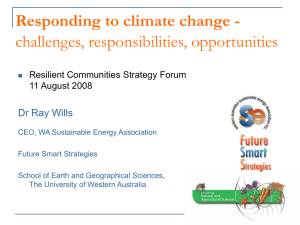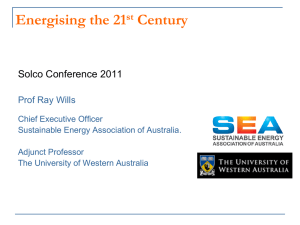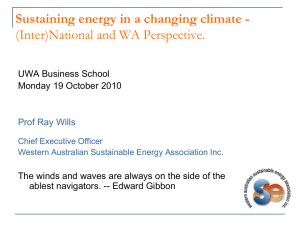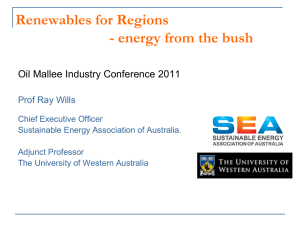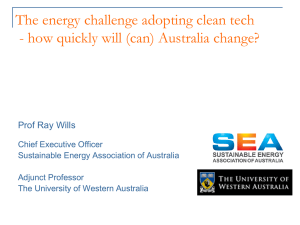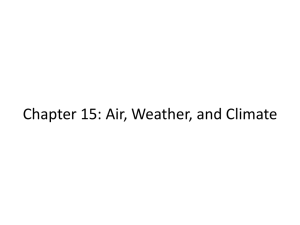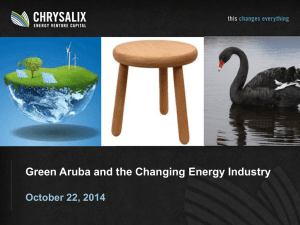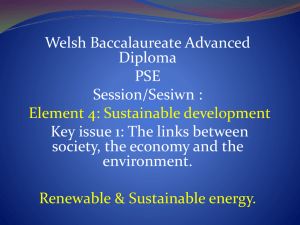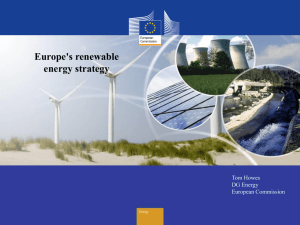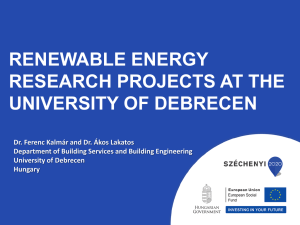Wills-U3A-jun-2011 - Future Smart Strategies
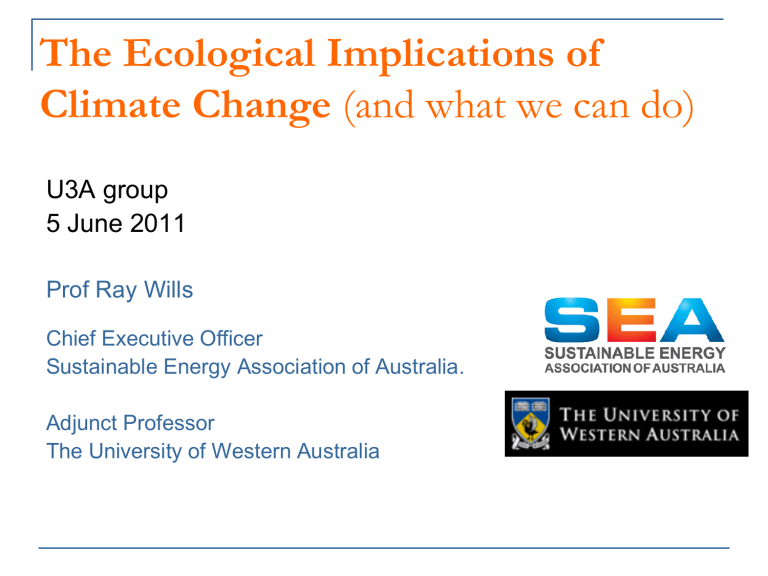
The Ecological Implications of
Climate Change (and what we can do)
U3A group
5 June 2011
Prof Ray Wills
Chief Executive Officer
Sustainable Energy Association of Australia.
Adjunct Professor
The University of Western Australia
A changing climate for business and the community
The science is in, the globe is warming, and we must both mitigate greenhouse gas emissions and rapidly prepare for adaptation to climate change.
A raft of immediately accessible and affordable solutions to reduce greenhouse emissions and provide alternative sources of energy are available today, and bring more and more business opportunity.
Spatial technology will be a key part of getting it right!
Greenhouse and global warming
Greenhouse theory is not new
Basis first proposed by in 1824
Greenhouse = earth ’s “blanket” average temperature about 15 °C; otherwise would be -18°C
Anthropogenic global warming theory late 1960 ’ s
UN and IMO lead debate late 1979
Intergovernmental Panel on Climate Change formed 1988
Rio 1992 Earth Summit, Kyoto 1997 …
Warming of climate is now unequivocal – global increases in air and ocean temperatures, melting of snow and ice, and rising sea level.
The enhanced greenhouse effect is not hypothesis
- it is empirically and theoretically well-established .
Drivers of climate change
Instrumental record - temperature
Instrumental record - temperature
Five-Year Av. Global Temp Anomalies from 1880 to 2010
Image deleted to reduce file size – see ref at http://data.giss.nasa.gov/gistemp/animations/
History of world temperature
Evidence of global warming
Climate and sea level changes
http://nsidc.org/sotc/sea_level.html
About WA
About Australia
Warming of 1.0
° C will move climate belts ~ 150 km south.
Regional temperature change of 2 ° C will serious impact on most life forms (CSIRO forecast 5 ° C for SW WA by
2070).
Changes by 2040
About WA
Climate change is arguably the most important key threatening process to all biota.
Biota in narrow climatic bands are likely to suffer changes in the patterns of distribution and abundance of a range of species.
Impacts both direct - climate affecting plant species establishment and persistence, and indirect - climate impacting bushfire regimes or increased summer rainfall increasing the spread of dieback.
Rise of 2ºC results in loss of 66% of Dryandra species,
41% of Australian eucalyptus species (including many
WA species), and 100% of Acacia species.
Similar studies for fauna - all frog and mammal species
About WA
If global warming and drying of the south coast in WA sees temperature increases
> 2 ° C combined with a decline in rainfall consistently below 400 mm many species of
Proteaceae in WA's SW will be lost.
Eucalypts and Acacia too.
Likely the iconic Banksia and Dryandra will die out.
So too the animals that live on them.
About WA
Climate is key determinant for your garden - changes in climate will impact on what will grow.
About WA
Climate is key determinant of agriculture - changes in climate will impact on crops and livestock.
Rising temperatures will cause a shift in budburst, shorter growing seasons, earlier harvest dates, lower crop quality, changes in soil temperatures.
Wheat growing areas in SW WA seriously impacted
Northern wheatbelt likely to disappear, south reduced.
Wipes out most of an industry worth more than $2 billion.
Climate is a key influence in grape selection.
Shifting rainfall patterns and drier conditions will change the way vineyards operate and reduce the wine crop.
WA produces around 5% of all Australian wine, about 25% of wine in super-premium and ultra-premium categories.
Sea level changes
Mandurah at 1m sea level rise
Courtesy of WA Sustainable Energy Association
Economic models and paradigms
www.greenhouse.wa.gov.au/ documents/EGWAGO15.8.2005_000.pdf
About WA
Other WA impacts will be the same as around the world
Sea level rise and storm surge
Temperature – minimum rise faster than maximum
Changing rainfall and extreme storm events
Health and safety
Emergency response function
National security
Global warming will act as a ‘ threat multiplier ’
International security
Copenhagen
Global impact
FlightSuite, NHAW, Technorama, NASA - world flight patterns over 24 hours
Image deleted to reduce file size – see ref at http://www.youtube.com/watch?v=1XBwjQsOEeg
The price of non-renewable
Global renewables 2008, 2009, 2010,
2011…
2008 - world invested more in total on renewable energy
($155 billion) than on traditional energy ($140 billion)
Almost 50% of new generation built around the globe in
2009 was renewable energy - 80 GW of renewable power capacity built compared to 83 GW of fossil fuel plants
China almost half of 2009 total with 37 GW of renewables –
China now world's leader in renewable energy.
Renewable sources in 2009 25% global electricity capacity
1,230 GW out of
4,800 GW total (all sources, including coal, gas, nuclear)
In Australia renewable projects 24% - according to ABARE data
2010 early report $240 billion investment in 2010
Global Trends in Sustainable Energy Investment 2010, released on 15 July 2010
United Nations Environment Programme / Renewable Energy Policy Network for the 21st Century
Global renewables 2009
Global renewables 2009
World clean energy
Bloomberg-Liebreich.www.iea.org
World clean energy
Bloomberg-Liebreich.www.iea.org
World clean energy
Bloomberg-Liebreich.www.iea.org
World clean energy
Bloomberg-Liebreich.www.iea.org
Cheaper solar pv
Renewable energy generation
The resource
Resource distribution
- solar, geothermal,
Solar wind, wave, tidal, ocean current
Bioenergy and biomass productivity
Wind
Wave
Geothermal
Current
Biomass
All technologies have paybacks
Personal mobility
Private transport
Fuel efficiency, other energy sources
Transport
Energy storage key
New technologies may be disruptive
Commercial vehicles
Smith Newton electric truck
Mega electric diesel hybrids
Mitsubishi Fuso
London Bus
GE Haul Pak
Honda prime mover
Oshkosh Military Vehicle
Electric mass transit
Siemens Bordeaux light rail
Bombardier wireless light rail
Slim Ride -15 passengers
Series 700 Shinkansen train – 285 km/h
Green homes
Smart grids, smart houses (and offices)
Integrated energy planning
Smart grids to coordinate the actions of devices such as loads & generators
Green precincts, green towns, green cities, smart cities
Global
Tianjin Eco-City China for 350 000.
$10bn green new city for 225,000 people, Portugal.
Masdar City $US22 billion for 50 000.
Australia
City of Sydney – 70% CO2 reduction by 2030
City of Melbourne
Stirling City Centre
Cockburn Coast
Fremantle
Alkimos
Yanchep Beach
Don’t build in disaster
Smart politics
Energy efficiency
Sustainable energy
- and energy efficiency
Energy efficiency in all forms
Distributed, renewable energy
Known costs, resource life 1000++ years
Stored energy in commodities, desal
Energy storage key to:
improved energy delivery increased reliability reduced emissions
Walmart
Wesfarmers
Waves of innovation
What we can create with energy conservation, energy efficiency, and renewable energy
Image removed to reduce file size – visit http://www.thefuntheory.com/piano-staircase
Industry chamber for any businesses / enterprise in sustainable energy or being more sustainable
Based in Perth, over 400 members nationally
Information, communication, and networking businesses
Government advocacy (lobbying)
Policy development
Legislation, regs and taxation - barriers and incentives
Education, skills and training
Calls for government leadership - and procurement
Industry mapping
Energising Kids – energy for the next generation
www.seaaus.com.au
